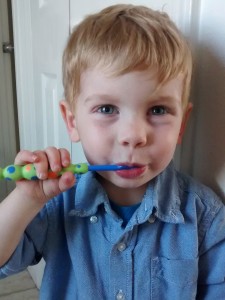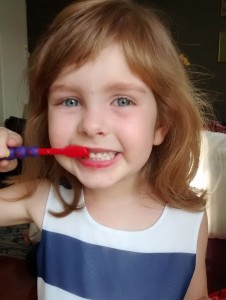
Set your child up for healthy habits in the future by fostering an early awareness of proper dental hygiene. Photo: American Ratings Corporation (2016)
You’re likely aware of the importance of dental health, but you probably didn’t start out that way. After all, knowledge of proper oral hygiene isn’t innate; rather, it’s something that’s instilled in us over time, beginning from a young age. So, in order to set the stage for long-term dental health, parents of young children need to be proactive about teaching healthy habits early. Here’s a brief overview of how to care for your child’s dental health throughout the seminal phases of childhood:
Infancy
Dental care begins at birth. Even before teeth begin to come in, dentists recommend cleaning an infant’s gums with a wet washcloth or gauze pad following each feeding. Once your baby’s first teeth emerge (typically at 6 to 8 months), begin brushing them twice daily, using an amount of fluoride toothpaste no bigger than a grain of rice. It’s also a good idea to give your baby water after nursing—by washing away any residual milk, this will help prevent “bottle rot,” which is a common form of infant tooth decay.
The American Dental Association recommends bringing your baby for its first dental exam within six months of getting its first teeth, or, at the latest, by age 1. During this initial appointment, your dentist will check for any problems and show you how to properly clean and care for your baby’s teeth.
Toddlerhood
By age 3, all of your child’s baby teeth will likely have emerged. In addition to supervising and assisting with tooth brushing, you should begin flossing your child’s teeth once they’re in contact with each other. Due to the level of dexterity it requires, most children aren’t able to floss on their own until well into grade school. Also, if you live in an area where the community water isn’t fluoridated, your dentist may recommend a fluoride supplement as an additional preventative measure against tooth decay.
At this point, you might be thinking, “They’re just baby teeth—why is maintenance so important if my kid is going to lose them anyway?” Not only do primary teeth help shape children’s eating and speaking development, they also play an important role as “space savers” for permanent teeth. When a baby tooth is lost prematurely, neighboring teeth can drift into the now-vacant space. Later, when the permanent tooth starts to erupt, there may not be enough room for it to come in properly. In this case, to avoid issues like crooked or crowded teeth, your dentist may recommend a space maintainer to “reserve” space for the incoming permanent tooth.

Taking care of your child’s baby teeth will help ensure correct spacing and placement of the permanent ones. Photo: American Ratings Corporation (2016)
By age 3, a child should begin having routine dental exams. Daniel R. Pestana, DDS suggests preparing your child beforehand by reading and talking to them about the dentist. “If you can get your kids comfortable with dentist visits at an early age, by the time they start forming permanent memories, they’ll already have positive feelings about it,” he explains. “When children have a positive association with going to the dentist, they’re more likely to want to get cleanings and be healthy. On the other hand, when they have a fear of the dentist, it tends to have the opposite effect. Because of this, children’s feelings about the dentist can indirectly affect their dental health for the rest of their lives.”
Childhood
Children’s first permanent molars typically come in at age 6, which is around the same time they start to lose their baby teeth. Once these molars have erupted, you should talk to your dentist about sealants. “A sealant is a thin plastic film that protects cavity-prone surface areas of the teeth, such as the tops of molars,” explains Dr. Pestana. “Sealants have become standard in dentistry because they’re a simple way to prevent major issues. I’ve seen several cases where adults have had multiple restorations on a first molar and eventually end up losing it because it cracks, which is a situation that could’ve been avoided if sealants had been applied.” Dr. Pestana says sealants can be a useful measure all the way up to age 12. “Kids’ hygiene isn’t always the greatest, but parents aren’t going to be cleaning their 12-year-old’s teeth, so sealants are a good way to get some extra protection against cavities.”
Another way to safeguard your child’s dental health is to monitor his or her diet. Every time food enters the mouth, an acid reaction occurs as the bacteria digest the sugars, which is the root cause of most oral health problems. This can be particularly detrimental for those with diets high in carbohydrates and sugar because it causes their saliva to be thicker, which facilitates more of the acid-producing bacteria. For this reason, limiting your child’s intake of sugar- and carbohydrate-rich foods will promote better oral (as well as overall) health.
Throughout subsequent stages of your child’s development, remember to consult the guidance of your dentist. Besides helping maintain your child’s gums and teeth, your dentist will be able to identify developing issues and recommend preventative solutions, which will result in greater long-term health.
Find a Diamond Certified dentist in your area.
One Response
Leave a Reply
You must be logged in to post a comment.

I like what this article mentions about making sure the kids have healthy diets. I think this could be a great way of keeping their teeth healthy and looking clean. It’s definitely something to keep in mind, especially as they get older. Thanks for sharing!